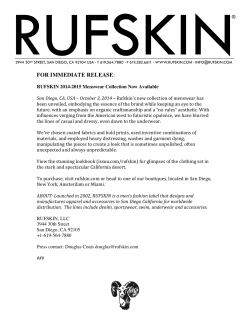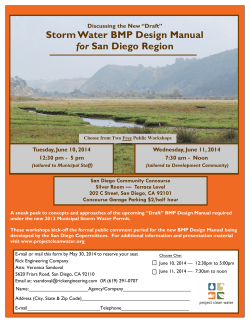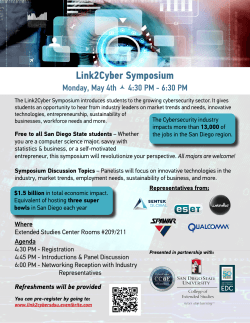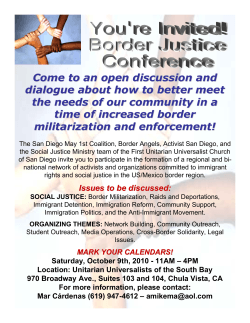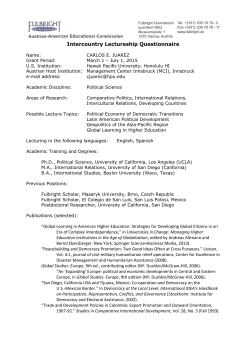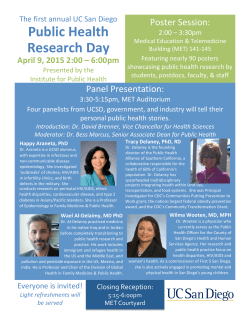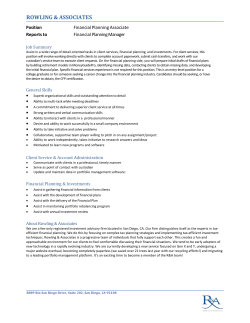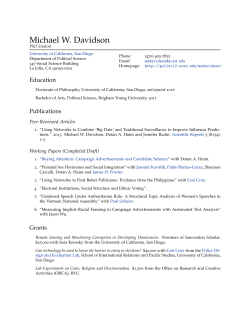
PAST, Present & Future - Department of History, San Diego State
SAN DIEGO STATE UNIV ERSITY DEPARTMENT OF HISTORY e r u t u F resent & PAST, P Volume 12 May 2015 Spring into Summer message from the Chair, Joanne Ferraro As usual, the History Department has been engaged in a flurry of activity this year. It was time for our five-year external review. Evaluators from some of our nation’s top research universities visited our department and assessed our program. I am very proud to report that they praised us for our emphasis on interactive teaching and on building our students’ skills in writing and communication, for our state-of-the-art assessment tools, for our scholarly productivity on a par with Research One institutions, and for our open and collegial work environment. Kudos! Our reviewers also noted that History is actively meeting the university’s strategic plan through faculty commitment to student mentoring and student excellence in research. In this issue you will read about Phi Alpha Theta’s activities, the wellpublicized research accomplishments of Professor Sarah Elkind’s students at the Oakland Museum of California, and the advanced internships in public history undertaken in History 452. We are also keenly interested in our alums, whose thoughts and activities are reported in our “Life after Graduation” series. We remain true to the title of our Newsletter, honoring our past in addition to sharing present achievements and future plans. This spring we had two special emeriti visit us, Professors Joyce Appleby and Howard Kushner. They met with faculty and students to discuss their recent scholarship as well as to learn about how the History Department has evolved since their time here. It was a poignant moment that reflects our respect for departmental continuity. During the visit of these two monumental teacher-scholars we stressed the importance of mentoring, not just for students but also among colleagues past and present. In this issue faculty have lots of good news to share, including my own selection as SDSU’s 25th Albert W. Johnson Lecturer with the new title of Distinguished Professor of History. We are also happy to report that Ranin Kazemi will join our ranks in Fall 2015 as an Assistant Professor of Middle Eastern History. Finally, it is with mixed feelings that we announce Elizabeth Cobb’s new appointment as the Melbern Glasscock Chair in American History at Texas A&M University. We heartily congratulate her on her new, distinguished appointment but we are very sorry to lose our valuable colleague. Inside this issue: Chair’s Message Appleby Lecture Ferraro Distinguished Prof. New Professor Phi Alpha Theta Trip History Internship Student Internship Updates History Graduate Updates History Dept. Good News Visiting Professor Student Awards PAGE 2 PAST, PRESENT & FUTURE The Andrew Bell Appleby Memorial Lecture and Book Discussion with Joyce Appleby By Eric Spoelstra The Appleby family has had a resounding influence on the History department at San Diego State. On April 16 th and 17th we were again reminded of their contributions to the historical discipline and the deeply curious natures that have encouraged meaningful and collaborative work here at SDSU and in their fields. On Thursday April 16 th Joyce Appleby who was a long time professor and later assistant dean at SDSU and is a professor emerita from UCLA came to lead a discussion group of her latest publication, titled Shores of Knowledge: New World Discoveries and the Scientific Imagination with Professor Eve Kornfeld moderating. Joyce Appleby shared that the genesis of the book was her desire to understand why people in Europe became so curious about the world around them. In Shores of Knowledge she argues that Columbus’s accidental collision with the shores of the Americas unleashed the imagination of Europe. No longer were people satisfied with the conventions of the day. Instead they sought to explain, collect, categorize, and experiment on the world around them. She consistently showed how their fascination with the natural world was inspired by the discoveries in America. Shores of Knowledge traces European writers, explorers, and scientists, beginning with Bernardino de Las Casas and ending with Charles Darwin. Joyce Appleby’s acumen is that she is able to draw together these otherwise disparate and diverse men into a clean and enlivening narrative that informs just as much as it entertains. It was a pleasure to hear Joyce Appleby explain her own excitement about these historical figures and the questions they sought to answer, such as setting out on global expeditions to determine if the world was shaped like a tube or a tomato. The book discussion prompted roundtable conversations about the continuity or exceptionalness of human inquiry, the importance of information exchange, and ways of teaching World History. Surely a book that can spark discussion into these topics merits the highest praise. On April 17, 2015, the SDSU Department of History’s annual Andrew Bell Appleby Memorial Lecture was presented by Howard Kushner who is the Nat C. Robinson Distinguished Professor of Science and Society at Emory University and holds a joint appointment as Professor in the Department of Behavioral Sciences and Health Education in Rollins School of Public Health and in the Graduate Institute of Liberal Arts in the College of Arts and Sciences. Prof. Kushner’s lecture, entitled, “Andrew Appleby, SDSU, and the Applied History of Medicine” was dedicated to Andrew Bell Appleby’s wife, Joyce Appleby, who was in attendance. In his lecture, Prof. Kushner talked about how Andrew Appleby’s scholarship and influence has impacted SDSU and Prof. Kushner’s own research. When Prof. Kushner was a young professor at SDSU, Appleby, who was a senior colleague, proved to be an inspiring and supportive mentor who defended Kushner’s innovative research methodology. In regards to his scholarship, Prof. Kushner continues to teach from Appleby’s innovative book Famine in Tudor and Stuart England, which used contemporary insights into the nature of epidemics in developing countries to conclude that the sensational Black Death in the 14 th century killed fewer people than famine. It was Andrew Appleby’s emphasis on interdisciplinary collaboration that led Prof. Kushner to play an integral role in the formation of SDSU’s Master of Arts in Liberal Arts and Sciences (MALAS), an interdisciplinary/cultural studies graduate program. Because of the problem solving skills Prof. Kushner learned from Andrew Appleby, he made the jump from his original focus on American foreign policy, writing about the 1867 Alaska Purchase, to writing books on medical topics such as suicide, Tourette’s Syndrome, Kawasaki’s Disease, and left-handedness. Prof. Kushner discussed the importance of historical skills for research in many medical fields and the need for interdisciplinary collaboration to solve problems. Prof. Kushner’s presentation was an inspiring example of the value of historical research skills to solve a range of problems in the past and present. It was also a reminder of the influence Andrew Bell Appleby and Joyce Appleby have had in inspiring SDSU’s history department toward greater productivity and versatility. PAST, PRESENT & FUTURE PAGE 3 Professor ferraro awarded distinguished professorship By Annika frieberg This year, Joanne M. Ferraro was selected for the Albert W. Johnson Research Lectureship, SDSU's most prestigious research award. It is given annually to one SDSU faculty member for outstanding achievement in research and scholarship, and it carries with it the title of Distinguished Professor. Dr. Ferraro was the first professor from the humanities to be selected for this award in twenty-four years. On March 20, she gave the SDSU Andrew W. Johnson Research Lecture. Her talk was entitled “The Historian as Detective: Sex Crimes in Early Modern Venice.“ Distinguished Professor Ferraro was introduced by Provost and Senior Vice President for Academic Affairs Chukuka S. Enwemeka. The Provost quoted the positive reviews of Dr. Ferraro’s most recent monograph Venice: History of the Floating City (published with Cambridge University Press in 2012) and he introduced some of those in attendance, such as former Provost Nancy Marlin and UCLA professor Geoffrey Symcox, who was Distinguished Professor Ferraro's dissertation advisor. In her address, Dr. Ferraro gave the audience deep insight into her archival work, offering them a glimpse of ordinary lives and social relationships in Early Modern Venice as shown in court documents. She addressed the challenges of doing research in the Venetian archives, showing how the historian’s craft is a multistage process of accessing, interpreting, selecting and narrating sources. In this particular case, they are further complicated by the density of legal abbreviations handwritten by scribes who never expected them to be read. Dr. Ferraro shared her more than thirty years of experience mastering the archives and the local Venetian dialect. She explained that her objective in doing all this detective work was to discover the voices and lives of ordinary people as opposed to the nobility and elites. Against the background of 16th century Venetian society, canon law, and the secular legal system, Dr. Ferraro presented several court cases. She untangled community and official perspectives on justice and sexual misconduct after 1563, when the law was changed to standardize marriage proceedings and people began to go to the courts to get their unwanted marriages dissolved. She uncovered the difference between men’s testimonies, women’s testimonies, and neighborhood involvement. In discontinuing marriages, Venetians drew on popular stories, fairy tales, and street theater, particularly stories about problematic arranged marriages, and Dr. Ferraro described to the university research community how she also incorporates these cultural and artistic sources into her work. As Dr. Ferraro explained, her research also extends to legal cases concerning abortion and infanticide. The courts tended to penalize unmarried women. However, Dr. Ferraro argued that men were often involved in acquiring herbs or powders to terminate unwanted pregnancies. Frequently, the Venetian community sympathized with the woman’s position, and aided and protected her. Dr. Ferraro added that in the social fabric of Venetian neighborhoods, prostitutes took on additional roles as marriage counselors, therapists, midwives, and mediators in moving babies into foundling’s homes. Throughout her well-attended lecture, Dr. Ferraro showed what historical detective work can do to uncover the voices of ordinary people. Contrary to standard understandings, neighborhood gossip and networks were deeply significant mediators of law and social conduct, often in opposition to the order imposed by church and secular authorities. After many questions from the large and engaged audience of students, staff, current and retired faculty, and campus visitors, Dr. Ferraro was presented with a plaque as Albert W. Johnson Distinguished Professor and a ten thousand dollar research award by Vice President for Research and Dean of the Graduate Division Stephen Welter. A reception followed in the Arts and Letters courtyard. PAGE 4 PAST, PRESENT & FUTURE New professor ranin kazemi The history department is pleased to announce that Ranin Kazemi will be joining us in the fall semester as our new historian of Middle Eastern history. Professor Kazemi earned a Ph.D. in History at Yale University in December 2012. He is interested in social and environmental history with a focus on the Middle East and North Africa, as well as the Caucasus, and Central and South Asia. In August 2012, he joined the Department of History at Kansas State University and obtained faculty affiliation with the Women’s Studies Department and the interdisciplinary Security Studies Program. At Kansas State, he taught courses in a wide variety of topics concerning the history of the Middle East and North Africa. He also offered classes on world history, historical methodology, and the international and social history of the Cold War. Arriving at San Diego State, he will be teaching HIST101 “World History” and HIST450 “The Writing of History” in the fall semester of 2016. Professor Kazemi has published extensively in leading journals in his field and is currently working on a book manuscript entitled The Ecology of Conflict: Privation, Protest, and Populism in Iran, 1850–1892. This project traces the economic, environmental, social, and political origins of one of the earliest national revolutionary movements in the modern Middle East. To complete this work, he has conducted research in Iranian, Turkish, British, French, Dutch, and American archives. His research has been supported by, among others, the International Institute of Social History and the Royal Netherlands Academy of Arts and Sciences, the Woodrow Wilson National Fellowship Foundation and the Charlotte W. Newcombe Foundation, the Council of American Overseas Research Centers, the American Research Institute in Turkey, the American Institute of Iranian Studies, and the Yale University Whitney and Betty MacMillan Center for International and Area Studies. We are thrilled to add such a talented teacher-scholar to our ranks. Visualizing The Past: World War I in Art By Michael Hosler-Lancaster, President, Phi Alpha Theta Every spring, members of Phi Alpha Theta take to the road in order to visit a culturally significant venue—both to “blow off some steam,” as well as to gain insight into how history is being presented to the public. This year, we decided to visit the Getty Center’s exhibit, “World War I: Images of War, War of Images.” The exhibit featured art produced throughout the First World War, and was timed to coincide with its centennial commemoration. What made this exhibit stand out, was that it brought the war to life, as they say, by telling the story of how art was used by the state and individuals in order to bolster support for their respective sides. With everything from propaganda posters aimed at military recruitment, to “battle art” created by soldiers fighting on the front lines on display, it became quite evident that attitudes and assumptions about the possible outcomes of the war drastically changed as fighting decimated large swaths of the European continent. Works produced early in the war seemed infused with a belief that the fighting would be short lived, and that the war would serve to “rejuvenate European culture.” Largely the result of restrictions against slanderous depictions of “the enemy,” enacted as a result of the Hague Convention of 1907, artistic expressions of the period were formulated in order to extol the virtues of a particular nation, as “those on both sides believed their culture to be innately superior to that of their enemy.” As more advanced mechanized weaponry capable of inflicting mass casualties was introduced into battle, and it became evident that there would be no swift victory for either side, artists began to depict the war in a far more gruesome manner, and often opted to portray the enemy as a threat to civilization, culture, and humanity. Art, it seems, took on a new role, and became a powerful weapon in the war for cultural superiority, and terrestrial dominance. PAST, PRESENT & FUTURE PAGE Sunshine and superheroes By proessor sarah elkind In May 2014, the Oakland Museum of California flew a dozen students to the Bay Area for the opening of "Sunshine and Superheroes," an exhibit on the history of Comic-Con and San Diego's tourism industry. The exhibit, open through this May, features action figures and vintage comic books collected and loaned by the students, videos by history major Parker Bray exploring the costumes people wear to Comic-Con, and a photobooth with capes, masks and other costumes for visitors to wear while they view the exhibit. "Sunshine and Superheroes" also examines the economic impact of tourism in San Diego, including the financial difficulties facing service industry employees here. The exhibit is one of a series of collaborative projects sponsored by the Oakland Museum of California in partnership with students at California State University campuses. Before "Sunshine and Superheroes," CSU-Sacramento students co-curated an exhibit on the Sacramento River, and CSU-Fullerton produced one on the recession in Orange County. The museum is currently working with students at San Jose State. Their exhibit will open in June 2015. The museum's goal is to provide students with hands-on experience in museum exhibit development, design and production, while offering visitors insight into issues and topics that are shaping communities throughout California. As the professor leading San Diego State's students through the process of creating the exhibit, I thought the collaboration with the Oakland Museum of California was a wild success. Students in a graduate seminar in American History started the project with readings on the history and politics of historical museums. They then selected the topic and researched the topic of ComicCon. The specific focus of the exhibit emerged from a great deal of discussion about what Comic-Con provided for the city and for attendees, as well as the controversies over expanding the Convention Center, and reports on the economic viability of tourism and service industries. Students then researched all exhibit topics, from San Diego's economic history to gender representations in popular culture, and post-World War II concerns that comic books fostered delinquency. One of the greatest challenges of the project was transforming these substantial research papers into exhibit labels of a few dozen words each. Oakland Museum's Associate Curator of Contemporary History and Trends Suzanne Fischer led the class through this difficult task, and showed students how to design a museum exhibit. "Sunshine and Superheroes" is just one example of the kind of student research that goes on in nearly every San Diego State history classroom. Stop by the Oakland Museum of California to see it, if you are in the area before the end of May. If you are interested in supporting history in the community, including this sort of student project at local museums and archives, contact the History Department. 5 PAGE 6 PAST, PRESENT & FUTURE Advanced internships in public history San Diego State University’s history program is both connected to and engaged with local history projects and historical outreach. Through the course HIST 452, we offer internship opportunities with local museums. These public history projects prepare ground for unique experiences for the students, prepare them for professional life and give them valuable work experiences. We asked some of the students in “HIST 452 Advanced Internships in Public History,” taught this year by Professor Kuefler, to tell us something about their internships. Internship at the San Diego Museum of Man By Samantha Darling The fact that history is an ever-evolving study is exactly what my archival internship at the San Diego Museum of Man has taught me. Twice a week I work to preserve fragile photos so that they may be available to the world and further researchers. I have learned how to handle aged documents and artifacts, categorize them, and further allow their accessibility via cataloging. This experience has opened my eyes to the world beneath the subject of history, which I have fervently pursued. The interns in the museum's Archives Department have the rare opportunity to see photographs and manuscripts from numerous points in time--even before their presentation to the public. We are trusted with this responsibility and greatly assist the museum with cataloging these priceless pieces of history. Archivists are the under-appreciated keepers of the past. I am thankful to be able to help the museum, for there seems to be more history than manpower. PAST, PRESENT & FUTURE PAGE Internship at the Veterans Museum and Memorial Center By Matt Monahan During the spring semester I have been an intern at the Veterans Museum and Memorial Center located in Balboa Park. The core goal of the VMMC is to honor the men and women who have served our country in the Armed Forces, Coast Guard, and Wartime Merchant Marine. I have had the privilege to help organize numerous war artifacts including uniforms, medals, pictures, personal accounts, journals, letters, posters, and books. As I research the many archives, particularly those related to women in war, I gain new insights into their valuable contributions in wartime and in peace. My volunteer hours have also included helping the museum directors move and arrange furniture and displays for future exhibits, meetings, memorials, and ceremonies. My experience at VMMC has given me a deeper appreciation for the person pictured in an old black and white photo, who wore that uniform, received that medal, or wrote that letter. This has allowed me to ‘see’ so many historical events firsthand through the eyes of the brave men and women who have served our country. Internship at Old Town San Diego Historic Park By Albert Cuadra Last summer I was fortunate enough to be involved in an amazing experience as an intern at the Old Town San Diego State Historic Park. During my internship I constructed a program of my own on the American West and the Ranchero lifestyle. I had the pleasure to meet and inform many visitors from both the San Diego area and other countries. With the help of my friends, other students who I met during the internship, we were able to reintroduce an already forgotten program in the McCoy House. It was an enlightening experience which we as SDSU interns enjoyed doing and I would be glad to return if time permits. Lastly, this was a fulfilling experience that helped me learn about other aspects of history: in this case, living history as an interpreter in a historic park. 7 PAGE 8 PAST, PRESENT & FUTURE Catching up with history graduates We thought it would be nice to hear from some of our graduates about life after graduation. Allison Dailey, who received her MA in History in 2012, Robert Famania, who received his BA in Social Science in 2013 and Javier Gonzalez-Meeks, who will receive his MA in History this summer all gave us a write-up on what is going on in their lives and how the San Diego State University History Department has contributed to their current endeavors. Teaching English as a foreign language By Allison dailey Hi Friends! My name is Allison Dailey and I graduated from SDSU in 2012 with my Master's degree in History. One of the main areas I focused on was Colonial Latin America. When I enrolled in the program I hadn't the slightest interest in this area, nor had I even thought about studying it, but sometimes life is funny like that. While working in the program I was constantly debating if I should continue on for my PhD. I'm an extremely indecisive person, and more so with important decisions. In the end I realized I would need to study Spanish before embarking on a PhD in the field of Colonial Latin America. So with the new desire and drive to learn Spanish I put my research skills to work and began to search for different options. How and where could I go to learn Spanish, but be able to work at the same time? Spanish is one of the most widely spoken language country-wise so at first it was hard to narrow down the options. However, I found a TEFL (teaching English as a foreign language) certificate course in Madrid. It seemed perfect. Not only was it a training course, but it also included a year of Spanish classes and a visa. I packed my bags and set off, for one year, to teach English and learn Spanish. Well, two and a half years later I'm still here! You´d be suprised how far being a native English speaker will get you in the world of TEFL, but having my Master´s has certainly given me an edge against other candidates. (Having teaching experience also helped!) Since moving to Europe I've taught in Spain, Ireland, and Turkey. It’s been an incredible journey, and I´m so lucky that I've gotten to travel and learn and experience new customs, languages, cultures, and history! Now, I am in my third year teaching English for both academies and for a program called Auxiliares de Conversación. I am in the process of applying to get another Masters, but this time in archeology, in one of my favorite Spanish cities, Granada. (One day I will accomplish my childhood dream of becoming Indiana Jones). Hopefully my Spanish is good enough! I'm a firm believer if you put out good vibes and the necessary effort into what you want, there's nothing to stop you! The history department at SDSU really helped me on the way! If anyone is interested in learning more about living in Spain, or teaching English abroad feel free to reach out! Peace & love PAST, PRESENT & FUTURE PAGE Teaching in high school By Robert famania Greetings, My name is Robert Famania and I am an Alumni of San Diego State University Class of 2013. My major was Social Science with an emphasis in single subject teaching. I am happy to relay that all my hard work at SDSU has been rewarded as I am currently teaching at Health Science High School a local charter school through San Diego Unified. I teach World History and United States History to tenth and eleventh graders. My time at San Diego State prepared me for my current teaching assignment through the rigorous challenges presented by the wonderful professors at SDSU. I had the distinct pleasure of studying under amazing instructors such as Clare 'Bud' McKanna, John Putman, Pablo Ben, and my alltime favorite Edward Beasley. These historians showed me that history is a story we all can learn from, relaying the information through comedy as well as pop culture. Some hidden truths can enlighten us all to where we have been, and where we are going. I currently use all of my SDSU professors’ teaching techniques in my classroom to inform the next generation of citizens. I also had the opportunity to join Phi Alpha Theta, the SDSU Historical Honors Society, where I met many other students who shared my love of all things historical and made many lifetime friendships. Extraordinary trips, fun activities, inspiring fund raisers and profession building seminars all brought me further into the folds of Phi Alpha Theta. I ended up serving as Vice President of Phi Alpha Theta in the year 2012-2013. Thank you to all the faculty and staff of San Diego State University and the College of Arts and Letters. My warmest regards to all P.A.T. members. You all have given me the tools to become the next great educator. Teaching in community college by Javier Gonzalez-Meeks I am an Adjunct History Professor at Grossmont College and Cuyamaca College. Over the last year and half, I have taught Early and Modern Western Civilization, Early and Modern World History, as well as Early and Modern American History. I also serve as the Grossmont College History Department’s AFT Union liaison. My history MA has served me very well after graduation. The SDSU History Program is well-respected within San Diego County and many of the full-time professors at local community colleges are SDSU History Department graduates. If you are interested in teaching at community colleges, I would recommend taking at least one or two history classes that are outside of your specialty, as you are often asked to teach more general classes or those outside of your area of expertise. I also found the Administration, Rehabilitation, and Postsecondary Education (ARPE) class that I took to be very useful in preparing me to navigate the community colleges I teach at. I completed ARPE 631 “Teaching in Postsecondary Education;” this is one of the four courses that they offer as part of their Community College Teaching Certificate. In addition, I would suggest that you apply for the San Diego/Imperial County Community College Association (SDICCCA) internship program; it is housed within the ARPE Department at SDSU. The SDICCCA internship program provides you with hands-on experience working in community colleges, navigating community college campuses and bureaucracy, networking, and assisting your SDICCCA mentor in the classroom. Finally, my experience working in the SDSU History Department as a Graduate Teaching Associate for Dr. Elizabeth Pollard and Dr. Stephen Colston has been invaluable in preparing me to teach my own classes. 9 PAGE 10 PAST, PRESENT & FUTURE History department good news Professor Emeritus Laurie Baron was appointed the Ida E. King Distinguished Visiting Professor of Holocaust and Genocide Studies for the fall semester of 2015 at the Richard Stockton College of New Jersey. He published the article: “Tarnishing Tinseltown: Hollywood’s Responses to Nazi Germany,” Journal of Jewish Identities 7:2 (July 2014), 59-78. He also gave a lecture: "Hollywood and the Holocaust: From Appeasement to Anti-Nazism, 1933– 1945" Allan and Norma Harris Memorial Lecture in Jewish Studies, Northwestern University, Nov.3, 2015. Joanne M. Ferraro was selected for the Albert W. Johnson Research Lectureship of 2015. She presented her Albert W. Johnson lecture “The Historian as Detective: Sex Crimes in Early Modern Venice” on March 20. Annika Frieberg was invited to participate in the conference “Political Reconciliation in Comparative Context” at Hong Kong Baptist University in Hong Kong, June 5-6, 2014. She will also be the co-editor of the volume coming from this conference. She also participated in the German Studies Association 2015 in Kansas City Missouri, Sept. 18-21, 2014. She presented her work at the Roundtable Seminar “Germany-Poland: Webs of Conflict and Reconciliation” Finally, she gave a lecture at the occasion of the Anniversary exhibition “1989: End of An Era” and screening of Andrzej Wajda’s film “Walesa: Man of Hope” in the presence of the Polish consul to the United States, Mariusz BRYMORA, at San Diego State University on Sept. 8, 2014. Bonnie Harris published the 2nd part of an article series for Asian Jewish Life about the Holocaust Story of Cantor Joseph Cysner in October 2014. See http://asianjewishlife.org/ . She is a contributing researcher and author to the encyclopedia entry about a little known Nazi labor camp at Zbaszyn, also known as "Bentschen," in The United States Holocaust Memorial Museum Encyclopedia of Camps and Ghettos 1933-1945, vol. 5, vol. ed. Martin Dean, series ed., Geoffrey Megargee (Bloomington: Indiana University Press in association with the United States Holocaust Memorial Museum, forthcoming). Eve Kornfeld received a service award from the Mayflower Colony of San Diego and the Sons of the American Revolution on Saturday 2/21, after addressing about 100 of their members on "The Many Faces of George Washington." PAST, PRESENT & FUTURE PAGE 11 History department good news (continued) Matthew Kuefler published an article, “The Merry Widows of Late Roman Antiquity: The Evidence of the Theodosian Code,” in Gender and History 27, no. 1 (2015): 28-52. He also published “Desire and the Body in the Patristic Period.” in The Oxford Handbook of Theology, Sexuality, and Gender, edited by Adrian Thatcher. Oxford: Oxford University Press, 2015. Pp. 241-54. In September 2014 Dr. Kuefler was invited and attended a conference titled L’autorité politique, le pouvoir et la masculinité: De l’Antiquité à nos jours. It was a conference organized by the Institut de l’Université de Londres à Paris, and held in Paris, France. His presentation was titled “The Christian Rulers of the Later Roman Empire: Between Bishops and Barbarians.” The proceedings of the conference will be published by Palgrave Macmillan. Professor Kuefler was invited to speak at Western Michigan University in Kalamazoo (home of the International Medieval Congress) in April 2015. The title of his talk was "The Chastity of Saint Gerald of Aurillac from Various Perspectives." Elizabeth Pollard’s book Worlds Together, Worlds Apart Concise, co-authored with Clifford Rosenberg (CUNY) and Robert Tignor (Princeton), has just been released (W.W. Norton 2015). A 75-minute "Meet the Author" session has been dedicated to the book at the annual meeting of the World History Association in Savannah, Georgia (29 June - 2 July 2015). Closer to home, and associated with the book's publication, Dr. Pollard gave presentations at several Nortonsponsored faculty development workshops (here in San Diego and at CSU Fullerton). She was elected to a 3year term (2015-2017) on the Executive Council of the World Historical Association. She is also serving a one-year term on the advisory board of the American Society of Papyrologists. Andrew Wiese completed the second edition of The Suburb Reader (first edition, Routledge, 2006) with coeditor Becky Nicolaides. The volume includes eight wholly revised chapters with dozens of new documents, essays and images. The book is in production with Routledge for publication in Jan. 2016. One of our graduate students, Jayme Naval, served as a research assistant, helping to identify and locate dozens of new items to review. This month, he was also re-elected to the board of the University Community Planning Group, one of forty such bodies across the city that reviews land use proposals as part of the city of San Diego's planning process. In the past year, he has served on subcommittees with input into the expansion of the Westfield -UTC mall, the Mid Coast Trolley, the Coastal Rail Trail and city Bike Master Plan, the new north UC Fire station, and efforts to preserve open space in the Rose Creek watershed. PAGE 12 PAST, PRESENT & FUTURE Department of History visiting professor Dr. leri tavadze San Diego State University has recently launched a great project that involves three leading universities from the Republic of Georgia. The project aims to establish an American education center (SDSU-Georgia Faculty) in Georgia to support and build better Georgian education. This bachelor’s degree program will enable students to earn both, SDSU and local Georgian bachelor’s degrees in six different programs. Among the participants of this project from the Georgian side is Ivane Javakhishvili Tbilisi State University (TSU). TSU is the oldest, largest and most popular university in Georgia. It was founded in 1918 by Ivane Javakhishvili, a famous Georgian historian. TSU has multiple disciplines and offers dozens of graduate, undergraduate and Ph.D. programs in almost every major area of study. There are seven faculties at TSU and one of the largest is the Faculty of Humanities. This faculty is the oldest faculty of the university and offers the most numerous programs among the other faculties of the same university. The leading positions in academic research at TSU is maintained by Kartvelology (sometimes described as Kartvelian Studies) – area of study that comprises the Georgia-oriented sciences like the Georgian philology and the Georgian history. The Institute of Georgian History is the leading division at TSU in the field of historical research. Under the guidance of Prof. Tedo Dundua (Vice-Dean of the Faculty of Humanities and the Director of Institute of Georgian History) the members of this institute are working on issues of Georgian and the World history. I am a member of Institute of Georgian History, but the area of my research reaches beyond Georgian history. My focus includes aspects of Byzantine and East European history in the Middle Ages. My lecture courses in Georgia cover many aspects of world history, as well as Georgian and Caucasian history. In the near future I will also be teaching for SDSU-Georgia’s general education program. My research is conducted in English as well as Georgian. I have held several international grants including the FaRiG Rothschild research grant, researching Georgian secular depictions between Sassanian and Byzantine depictions (http:// www.farig.org/research.html). Currently, I am also involved in the Online English-Georgian Catalogue of Georgian Numismatics.The catalogue will be the first scientific-research website about Georgian Numismatics and will cover many aspects of World history as far as Georgian coins and coin finds provide information. It will yield valuable research results, not only for the history of Georgia, but also other countries of Europe and the Middle East (http://geonumismatics.tsu.ge/en/) I have spent time at San Diego State University establishing contacts with the members of San Diego State University History Department and learning about preparation of syllabi, local teaching methods, and innovations. I have also met with the members of the History Department and Central Administration, been involved in meetings organized by the Center of Teaching and Learning, participated in the scientific-research conferences and given a presentation about the historical research in the Republic of Georgia. PAST, PRESENT & FUTURE PAGE 13 Student Scholarships and Awards Appleby Memorial Undergraduate Scholarship Melody Andrews, Tannis Presser Richard Ruetten Memorial Scholarship Linnea Zeiner Lionel Ridout Memorial Scholarship Jeffrey Brown, Mary Clipper Katherine Ragen Memorial Scholarship Steven Dichiera, Cameron Satterlee Kenneth & Dorothy Stott Memorial Scholarship Michael Hosler-Lancaster, Mayra Lopez Colonial Latin American History Scholarship Mark Jones Outstanding Graduating Senor in History Samantha Darling Outstanding Graduating Senior in Social Science Laura Bollbach Phi Alpha Theta Conference Papers Linnea Zeiner and Mary Clipper both won Honorable Mention for Graduate papers at the Phi Alpha Theta Southern California Regional Conference on April 11, 2015. Linnea's paper was titled "The Subversive Voice of Third Wave Feminism as a Play of Aporia in Grunge" and Mary's was "The Making of a Monster: Social Construction of the Muslim Terrorist as Evidence of Persistent American Orientalism." The papers are excerpts from Linnea's and Mary's MA theses, being written under the direction of Professors Eve Kornfeld and Paula DeVos. There were only 7 awards given for the 87 papers presented, and SDSU won two of them! Most Influential Professors The Outstanding Graduating Senior in History, Samantha Darling, has chosen Professor Annika Frieberg as her Most Influential Professor. The Outstanding Graduating Senior in Social Science, Laura Bollbach, has chosen Professor Farid Mahdavi as her Most Influential Professor. San Diego State University Department of History 5500 Campanile Drive San Diego, CA 92182-6050 Phone: 619-594-5262 Fax: 619-594-2210 http://www-rohan.sdsu.edu/~histweb/ Detach here…………………………………………………………………………………………………………………………………………………………………………………………………… I/we hereby donate to the Friends of History the sum of ____________________________________________________________ Name ________________________________________________________________________________________________________ Home Address________________________________________________________________________________________________ City/State/Zip _____________________________________________ E-mail address ____________________________________ Employer/Business Name ______________________________________________________________________________________ Class of __________________________________ Please send your donation to: Department of History 5500 Campanile Drive San Diego, CA 92182-6050 _____ Check here if you do not wish your name to be published as a donor.
© Copyright 2025
